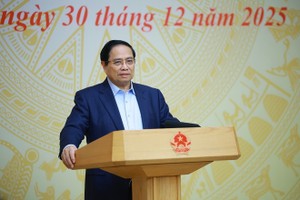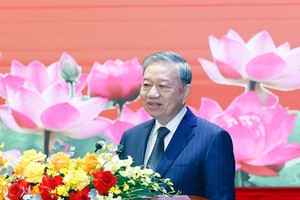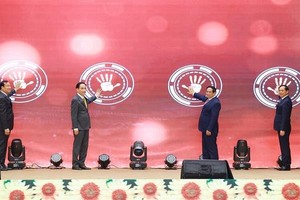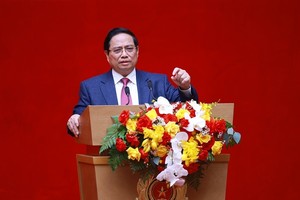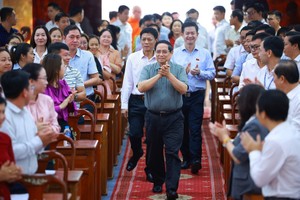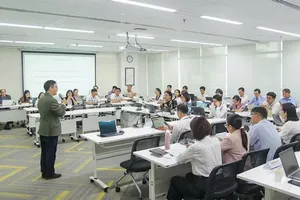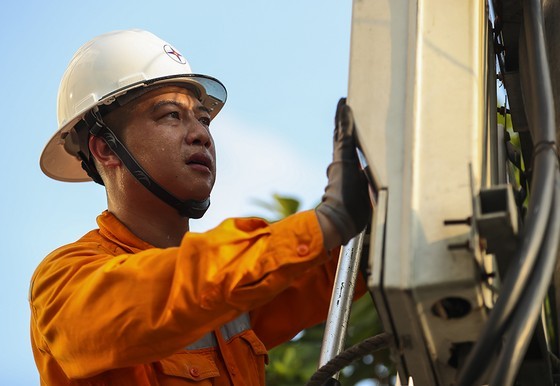 |
Electricity workers reconnect lines for households in Hanoi’s Long Bien District |
Although the heat wave has abated, many places across the country have had showers, the scorching summer parched hydroelectric reservoirs in Vietnam resulting in dwindling water levels.
As a consequence, hydropower plants had no choice but to stop electricity generation resulting in alternating power cuts in the suburbs of Hanoi and many localities in the North.
The total electricity output used is up to nearly 800 million kWh per day, but of which hydroelectricity can only meet more than 14 percent as many hydropower plants have to temporarily stop operation of turbines. The rest is from coal and gas thermal power accounting for nearly 73 percent.
Large-scale power outages occured in many areas in Hanoi and the North on June 6. Many places have announced the power outage schedule in advance from 8 am to 4 pm or 9 pm so that people and businesses can actively arrange work. In some places, people suffered power outages 2-3 times over the past week.
Data on water levels at hydroelectric reservoirs of the Electricity of Vietnam (EVN) updated on June 6 showed that 6 out of 7 hydropower plants in the North almost stopped generating electricity.
Even large hydropower plants such as Son La, Lai Chau, Tuyen Quang, and Thac Ba stopped generating electricity. Currently, only Hoa Binh Hydropower Plant is still discharging water to generate electricity. Previously, on June 5, Son La, Lai Chau, and Tuyen Quang hydropower plants also did not generate electricity.
According to the National Load Dispatch Center, it has proposed to suspend using hydroelectricity at some moments in order to use renewable energy such as wind power, wind power, and solar power instead in recent years.
Worse, the power shortage occurred this year because the water level in hydroelectric reservoirs had severely reduced and the amount of water in hydroelectric reservoirs in many places plunged to its lowest. As a result, some plants had to temporarily stop generating electricity to reserve for more stressful times.
At 11 a.m. on June 6, the volume of water in Huoi Quang hydropower reservoir was only 28.1 cubic meters per second while the volume of water in Ban Chat hydropower reservoir was 11.7 cubic meters per second, Thac Ba reservoir was 60 cubic meters per second, and Tuyen Quang hydropower plant was 110 cubic meters per second.
Because Son La and Lai Chau reservoirs do not discharge water, the amount of water in the Hoa Binh hydropower reservoir is only 380 cubic meters per second, while this plant has to discharge 886 cubic meters per second downstream for power generation. The discharged volume of water is 2.3 times the amount of water flowing into the reservoir.
The Thac Ba hydropower reservoir water level on June 6 was still below the dead level with only 60 cubic meters per second. On June 5, Thac Ba Hydropower Plant still generated electricity with a flow rate of 112 cubic meters per second but on June 6, it was temporarily closed.
According to an investigation of the SGGP Newspaper, a number of hydropower plants in the Central region were suspended from electricity generation on June 6. Only most hydropower plants in the South Central region, Central Highlands and Southeast are still in operation.
The National Load Dispatch Center reported that the largest capacity on June 5 was 37,950.3MW whereas 789.8 million kWh was consumed on the day. Electricity mobilized during the day includes 113.3 million kWh from hydropower, 482 million kWh from coal thermal power, 92.1 million kWh from oil and gas energy, 1.3 million kWh from thermal power plants, 71.1 million kWh of solar power, 17.2 million kWh of wind power and 1.8 million kW of other sources. Vietnam also bought 11 million kWh of electricity.
In the context of a very difficult power supply, in its written request to its member units in the North, the state power utility EVN urged to implement urgent power-saving measures from now until August 2023. At the same time, officials and employees of EVN have to encourage people to save electricity.


